Travel guide: Zanzibar mini break
Omani architecture, white-sand beaches, blindingly blue water – thinking of a trip to Zanzibar? Read this first.
The turquoise of Zanzibar’s Indian Ocean is the kind of vivid blue-green you usually only see in postcards. Add to that the clear water, the white sand so fine it feels spongy underfoot and the statuesque palm trees, and you have the recipe for a perfect beach break.
But this predominantly Muslim archipelago isn’t just about sunbathing – there are plenty of activities to fill your days, as well as a 2,000-year-old history to pour over that’s seen the Portuguese, Omanis and Brits rule the islands.
Here’s how to immerse yourself in Swahili culture and get the best out of a long weekend (or more) in Zanzibar.
TO DO LIST
Wander around Stone Town
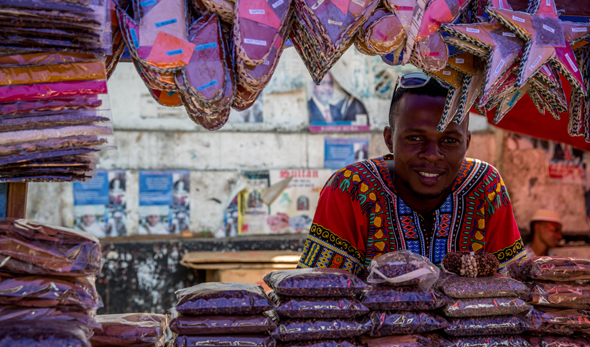 People are genuinely friendly in Zanzibar
People are genuinely friendly in Zanzibar
Narrow, dusty alleyways, rooftop tea houses, old palaces with ornate wooden verandas – Stone Town isn’t Zanzibar’s business centre, but it is the historical and cultural heart of the island. It’s a protected Unesco World Heritage Site too.
The 19th century neighbourhood is fairly small so you can get around without a map (you’ll spit yourself out of an alleyway and on to the main coastal street if you wander around long enough anyway).
Photographers will love the worn yet majestic mishmash of architecture – the fact the Omanis ruled over the town for so long is clear from the dark wooden doors that welcome you into the whitewashed and pastel buildings.
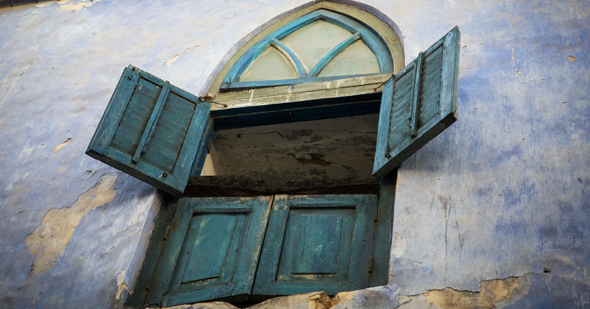 The Omani influence is clear in Stone Town’s architecture
The Omani influence is clear in Stone Town’s architecture
Make sure to pick up some Tanzanian chocolate from one of the shops, as well as a piece of jewellery crafted from the light purple stone that is Tanzanite (you’ll pay a lot less in Stone Town than you will at the Gold & Diamond Park in Dubai, even without haggling).
The other thing you’ll need to do to truly enjoy your time in Zanzibar, however, is reset yourself so that you’re on island time. Service here can be so relaxed it’s perplexing, so if you order an octopus curry for lunch from a Stone Town restaurant, be prepared to wait a while. For a wonderful lunchtime spot, try Lazuli – an adorable little café in the heart of Stone Town that serves a mean smoothie and properly fresh juices.
Go on a ‘Safari Blue’ tour
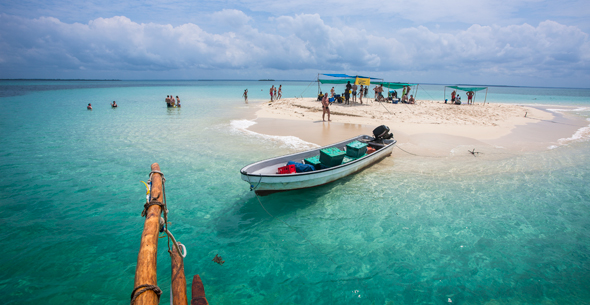 The Safari Blue tour will take you out to tiny sandbank islands
The Safari Blue tour will take you out to tiny sandbank islands
The luxury of some of the resorts and the prices you pay can be jarring in a place where the average local earns just Dhs4 a day. But remember, every dollar you spend serves the island’s people, so spread it around and use it at some of the smaller, more local businesses.
As you wander down any beach, locals will come up to you and offer to take you on a ‘Safari Blue’ tour, which basically means a full day out on the ocean snorkelling, eating, sunbathing and sailing. Everyone calls their tour ‘Safari Blue’, but there’s an actual tour company called Safari Blue that started the tradition back in 1997 (and is a local company too). The day out involves boat trips with dolphins, sunbathing on isolated sandbank islands, Swahili lunches, snorkelling in clear water over lively reefs, snacking on exotic fruit, sailing a dhow and climbing a baobab tree. So yes, they pack lots in, but for Dhs240 per person, it’s worth it.
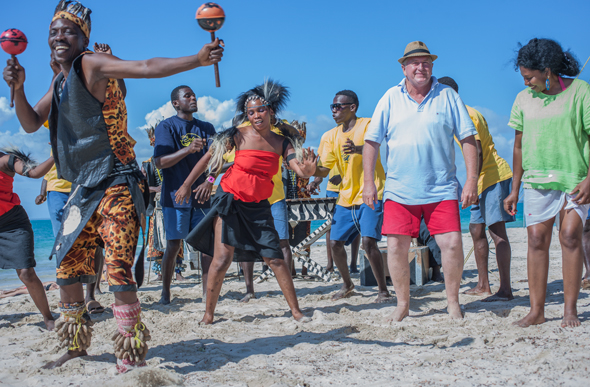 You’ll learn a bit more about Swahili culture on the day out too.
You’ll learn a bit more about Swahili culture on the day out too.
Visit Prison Island
Just 20 minutes by boat from the beach near Stone Town, this unattractively named island is famous for being home to Aldabra giant tortoises – majestic, huge creatures that can live to up to around 150 years. In 1955 there were more than 200 on the island. Sadly that number was depleted when people began to sell and steal the animals. The number plummeted to only seven in the mid-’90s, but the conservation team on Prison Island has managed to bring the population back up to around 100.
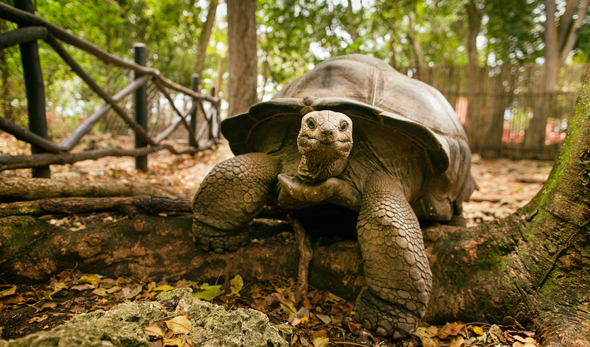
How do you get to Prison Island? Well, go to the beach right next to the Park Hyatt in Stone Town and flag down a boat with ‘Mr Bean’ or ‘Jambo’ written on it. These guys will take you to the island and give you a tour for a negotiable price – aim for around Dhs70 per person.
After feeding the tortoises, take a tour of the eerie 1800s prison on the island. The island was once used as a quarantine for those trafficked in slavery in the 19th century – a stark reminder that Zanzibar was a key port in the global slave trade of the time.
GET ME THERE
Flydubai flies to Stone Town two times a week from Dhs1,150 return on economy, or Dhs2,225 return on business. Flight time is around six hours.
STAY
Park Hyatt, Stone Town
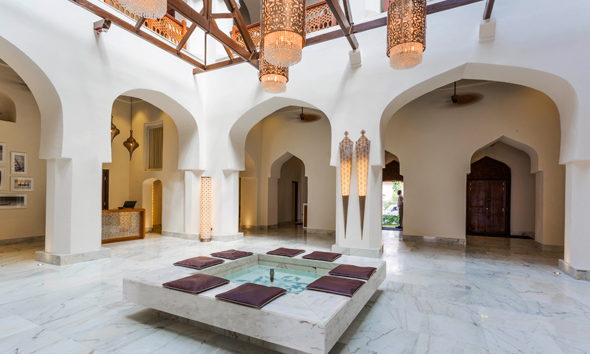 The hotel’s grand old lobby
The hotel’s grand old lobby
Just ten minutes from the airport and right in Stone Town, we recommend staying here for a night or two before you head out for your beach break. The beautiful hotel is as well run and chic as you’d expect from a Park Hyatt, and it’s set on the water in a 150-year-old Omani trader’s mansion. It’s the perfect base for exploring Stone Town. Breakfast on the terrace is a good way to start your holiday. Expect to pay around Dhs1,000 per room with breakfast.
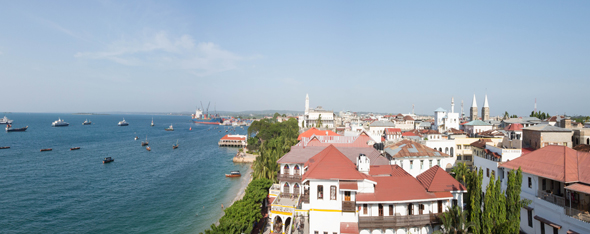 The hotel is right on the ocean in Stone Town.
The hotel is right on the ocean in Stone Town.
Zanzi Resort
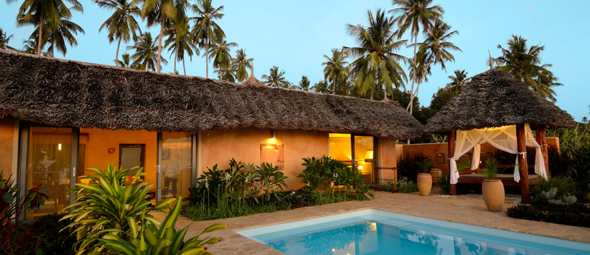
An intimate resort with a private, stony beach. Hop in a kayak (they are free to use) and paddle to the deserted beach near the hotel. There are six villas and six garden bungalows. Rooms cost Dhs1,100 (or Dhs1,660 all inclusive).
FAST FACTS
– Zanzibar is just 30km off the coast of the Tanzanian mainland
– There are many islands in Zanzibar, but the main one to visit, and the one you’ll fly in to, is Unguja
– The Tanzanian shilling is the local currency, but USD is accepted almost everywhere
THINGS TO KNOW BEFORE YOU GO
THE AIRPORT
The Abeid Amani Karume International Airport is the main airport in the Zanzibar archipelago. It is an experience in itself, and not in a good, Singapore-Airport-and-its-science-museum kind of way. Give yourself at least three-and-a-half hours to get from the entrance of the airport (where you’ll stand outside in a giant crowd of a line for at least an hour) on to your plane. It’s that hectic.
TIME TO VISIT
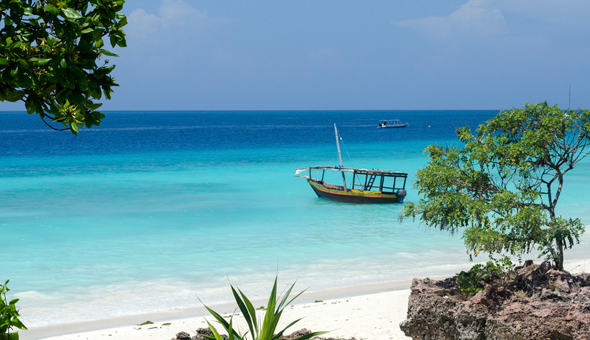
Zanzibar is in the Southern Hemisphere, so escape the desert heat and head to Tanzania during its ‘winter’, ideally from June through to October when the average temperature is a very comfortable 25° Celsius. July and August are also the perfect months to scuba dive off the north coast. Zanzibar has two rainy seasons – from mid-March to late May, and again in November.
YELLOW FEVER & MALARIA
Zanzibar isn’t a super high risk area, but prophylactic tablets just require a prescription, and there are many on the market so discuss it with your doctor. Yellow fever injections can be administered at a UAE government health centre. Some advice says you’ll be stopped in Zanzibar or in the UAE to check if you’ve been vaccinated. The jab lasts for more than ten years, and it’s a live vaccine so there can be some flu-like side effects – plan ahead.
– For more about Dubai straight to your newsfeed, follow us on Facebook.
Photos: Getty/Supplied
